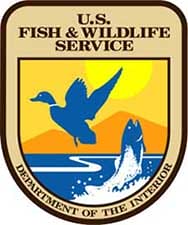

Cheyenne, WY -(Ammoland.com)- U.S. Fish & Wildlife Service Director Dan Ashe and Wyoming Governor Matt Mead today announced the launch of the nation’s first conservation bank for greater sage-grouse.
The bank will manage a vast expanse of central Wyoming for sage-grouse, mule deer and other wildlife, allowing energy development and other activities helpful to the regional economy to proceed on lands elsewhere in the state. At a signing ceremony in the rotunda of the State Capitol, Deputy Director for the Service Jim Kurth and Governor Mead joined Jeff Meyer, Managing Partner of the Sweetwater River Conservancy, in formalizing the agreement creating the project, which will rank as the largest conservation bank in the country.
At the heart of the conservation bank is the Pathfinder Ranch, a 55,000-acre working cattle ranch located west of Casper near Pathfinder Reservoir that provides significant wildlife habitat for the greater sage-grouse and other native species. Originally purchased for wind energy development, the project was converted to a conservation bank and deeded to the newly created Sweetwater Conservancy with the encouragement of former Governor Dave Freudenthal, who was in the process of building Wyoming’s Core Area sage-grouse strategy. As the demand for credits grows, the bank could expand to 700,000 acres on other lands owned by the Conservancy.
“Protecting the very best sage-grouse habitat is a vital part of the long-term conservation strategy for this bird and the hundreds of species that depend on healthy sagebrush ecosystems,” Ashe said. “The Service is committed to continually exploring new and innovative ways to work with states, industry and private landowners to protect sage-grouse and the vitality of rural communities across the West.”
A conservation bank is a site or suite of sites established under an agreement with the Service to provide conservation benefit for species. Entities can purchase “credits” that that result from perpetual conservation easements and conservation projects on the land and are used to offset impacts occurring elsewhere.
“Wyoming continues to work on practical and effective means to ensure a healthy population of sage-grouse,” said Governor Mead. “Here private landowners, state and federal agencies worked together and the result is this innovative conservation plan. I applaud everyone who took part.”
In 2010, the Service determined that the greater sage-grouse warranted protection under the Endangered Species Act (ESA), but was precluded by higher priorities. Since then, a remarkable, broad-based coalition of stakeholders has come together across the bird’s 165 million-acre, 11-state range to address threats and prevent the need for a listing. Market-based mitigation tools such as conservation banks, and the financial incentives they provide, are valuable for conserving the habitat required for abundant, well-distributed sage-grouse populations.
Most of the Sweetwater River Conservancy Conservation Bank is classified as core sage-grouse habitat by the State of Wyoming, a designation applied to areas of the highest sage-grouse populations. In addition to sage-grouse, the Conservancy will manage the property for the benefit of other wildlife and to promote improved water quality and quantity on the property. The Wyoming Stock Growers Agricultural Land Trust has been selected to hold and administer the conservation easements in perpetuity.
“Sweetwater’s goal is to protect and enhance some of the nation’s best sage-grouse habitat while delivering an important tool that will contribute to the long-term health of Wyoming’s business community,” said Jeff Meyer, Managing Partner of the Sweetwater River Conservancy. “Mitigation credits created on this landscape will be available to offset unavoidable impacts of economic development by supporting permanently protected, high-quality habitat for the greater sage-grouse.”
Neil Kornze, Director of the Bureau of Land Management (BLM), a key federal agency partner in conservation efforts for the greater sage-grouse, said “Meaningful mitigation is central to the BLM’s mission to manage the public lands under the principles of multiple use and sustained yield. Today’s announcement demonstrates that forward-looking approaches to mitigation can provide real benefits for investors, for industry, and for conservation.”
A review team has guided the conservation bank’s creation and will continue overseeing its long-term management. Team members include representatives from Wyoming Department of Environmental Quality, Wyoming Game and Fish, Wyoming Office of State Lands and Investments, Bureau of Land Management, Natural Resources Conservation Service, private landowners, and the Service
About U.S. Fish and Wildlife Service
The mission of the U.S. Fish and Wildlife Service is working with others to conserve, protect, and enhance fish, wildlife, plants, and their habitats for the continuing benefit of the American people. We are both a leader and trusted partner in fish and wildlife conservation, known for our scientific excellence, stewardship of lands and natural resources, dedicated professionals, and commitment to public service.
For more information on our work and the people who make it happen, visit www.FWS.gov.
